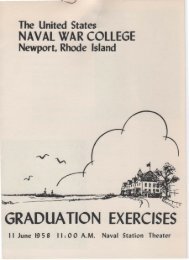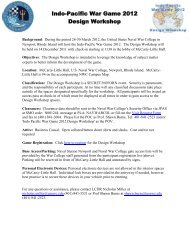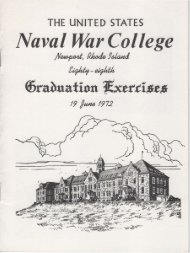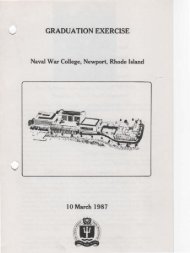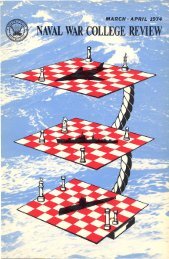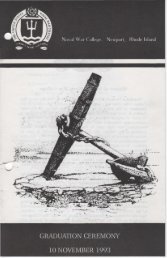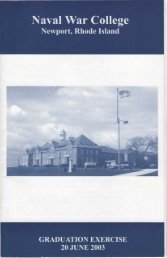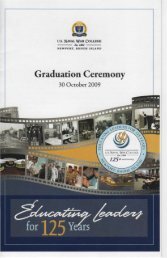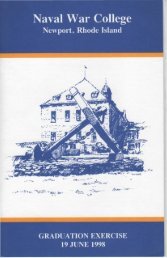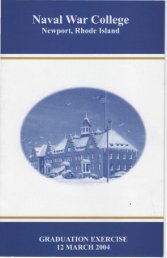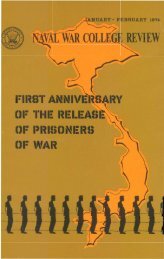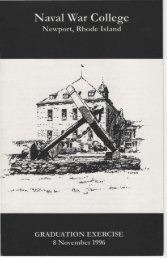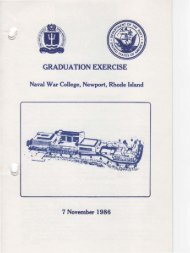11 March 2009 - US Naval War College
11 March 2009 - US Naval War College
11 March 2009 - US Naval War College
You also want an ePaper? Increase the reach of your titles
YUMPU automatically turns print PDFs into web optimized ePapers that Google loves.
THE ACADEMIC PROCESSION AND REGALIAFor centuries, institutions of higher learning have dignified theirceremonies with an academic procession, a custom descending from theclerical procession. The procession is led by a marshal, followed by thestudent body and the academicians or faculty, attired in the robes prescribedfor their respective degrees. Distinguished visitors and delegates follow thefaculty, and last in the procession comes the president of the institution.Each member of an academic procession ordinarily wears a cap, gown,and hood. In the procession today military faculty will not wear academicgowns. The earliest illustration of gowns worn at Oxford Universitysomewhat resembles cassocks worn by English teachers who found good usefor the hood, or cowl, as protection against the weather. A uniformAmerican system of academic heraldry displays the level of degree, the fieldof study in which it was earned, and the institution by which it was granted.It is the hood which provides academic regalia its color and offers the mostinformation about its wearer. The silk lining of the hood bears the color, orcolors, of the degree-granting college or university; its velvet facing reveals thecolor assigned to each area of study. The Bachelor's gown is relatively simple,falling in straight lines from an elaborate yoke and having pointed sleeves. TheMaster's gown is slightly more elaborate and fastens about the wrist. TheDoctor's gown is marked by velvet panels down the front and around theneck, as well as by three bars of the same material on the well-shaped sleeves.It is cut more fully and may be ornamented. The hood worn is three feet inlength for Bachelors, three and one-half feet for Masters, and four feet forDoctorates, with velvet trimming of two, three, and five inches in widthrespectively.The edging, or facing, velvet of academic hoods indicates the area of study.The principal scholarly fields seen in the procession today include:PhilosophyArts, Letters, HumanitiesBusiness AdministrationEconomicsEngineeringLawInternational Affairs/Public AdministrationDark BlueWhiteLight BrownCopperOrangePurplePeacock BlueThe American mortarboard, derived from the soft Oxford cap, is black. Itstassel, for holders of the bachelor's and master's degree, is usually black,while gold tassels are worn by holders of doctoral degrees and heads ofinstitutions. The tassel is worn on the right side of the cap byundergraduates, on the left by holders of bachelor's and higher degrees.
PROGRAMMaster of CeremoniesCaptain Sharon B. Campbell, U.S. NavyDean of StudentsProcession of StudentsArrival of Official Party*National Anthem*Sung by Mrs. Julie ZecherInvocation*IntroductionGraduation AddressDr. John H. MaurerChairman, Strategy and Policy DepartmentPresentation of DiplomasCharge to GraduatesRear Admiral James P. "Phil" Wisecup, U.S. NavyPresident, <strong>Naval</strong> <strong>War</strong> <strong>College</strong>*Guests please standBenediction*
Rear Admiral James P. "Phil" WisecupPresident, <strong>Naval</strong> <strong>War</strong> <strong>College</strong>Rear Admiral James P. Wisecup is a native ofPiqua, Ohio, and a 1977 grad uate of the U.S. <strong>Naval</strong>Academy. He earned his Masters Degree in InternationalRelations from the University of SouthernCalifornia, is a graduate of the <strong>Naval</strong> <strong>War</strong><strong>College</strong>, and he also earned a degree from Universityof Strasbourg, France, Institute for AdvancedEuropean Studies, as an Olmsted Scholar.Rear Adm . Wisecup served at sea in support ofOperation Desert Storm and Operation EnduringFreedom as Commanding Officer onboard <strong>US</strong>S Callaghan (DDG 994), ExecutiveOfficer on board <strong>US</strong>S Valley Forge (CG 50), and Commander of DestroyerSquadron 21.Ashore, Rear Adm. Wisecup was assigned to Nato Headquarters in Brussels,Belgium, was the force planner and ship scheduler for Commander, U.S. <strong>Naval</strong>Surface Forces, Pacific in San Diego, and served as action officer for Navy HeadquartersPlans/Policy Staff. He was selected to serve as a Fellow for the eNO StrategicStudies Group in Newport, Rhode Island and served as Director, WhiteHouse Situation Room. He most recently served as Commander, U.S. <strong>Naval</strong>Forces Korea in Seoul.Rear Adm. Wisecup's awards include the Bronze Star, Legion of Merit, DefenseSuperior Service Medal, Vice Admiral James Stockdale Award for InspirationalLeadership, plus other personal and unit awards.Rear Adm. Wisecup comes to the <strong>Naval</strong> <strong>War</strong> <strong>College</strong> after a highly successfultour serving as Commander, Carrier Strike Group Seven, and Commander, RonaldReagan Strike Group.
Dr. John H. MaurerChairman, Strategy and Policy Department<strong>Naval</strong> <strong>War</strong> <strong>College</strong>Professor John H. Maurer serves as the Chair ofthe Strategy and Policy Department at the <strong>Naval</strong><strong>War</strong> <strong>College</strong> in Newport, Rhode Island. He is agrad uate of Yale University and holds an M.A.L.D.and Ph.D. in International Relations from theFletcher School of Law and Diplomacy, Tufts University.Before joining the faculty of the <strong>Naval</strong> <strong>War</strong><strong>College</strong>, he served as executive editor of Orbis: AJournal of World Affairs, and held the position ofsenior research fellow at the Foreign Policy Research Institute. He served on theSecretary of the Navy's advisory committee on naval history. In addition, he is theauthor or editor of books examining the outbreak of the First World <strong>War</strong>, militaryinterventions in the developing world, naval arms control between the twoworld wars, and a study about Winston Churchill's views on British foreign policyand strategy. His current research includes work on Winston Churchill andGreat Britain's decline as a world power, and great power arms competitions. InJune 2001, he received the u.S. Navy's Meritorious Civilian Service Award.
COLLEGE OF NAVAL WARFARELieutenant Commander Martin F. Arriola, U.S. NavyCommander Anthony G. Battaglia, U.S. NavyCommander Joseph E. Bell, U.S. NavyColonel James W. Bierman Jr., U.S. Marine CorpsCommander Michael J. Burianek, U.S. NavyCommander Robert K. DeBuse, U.S. NavyCommander Robert J. Engelhardt, U.S. NavyMr. Brian M. Fiore, Department of the ArmyCommander Paul J. Foster, U.S. NavyCommander Darren J. Hanson, U.S. NavyCommander Bertram C. Hodge, U.S. NavyCommander Todd A. Hofstedt, U.S. NavyCommander William R. Irwin, U.S. NavyCommander Stephen J. Jackson, U.S. NavyLieutenant Colonel William M. Jurney, U.S. Marine CorpsLieutenant Colonel Patrick N. Kelleher, U.S. Marine CorpsLieutenant Commander James P. Lowell, U.S. NavyCommander Steven J. Mathews, U.S. NavyLieutenant Colonel Roger J. McFadden, U.S. Marine CorpsLieutenant Commander Philip S. Miller, U.S. NavyCommander Rodney A. Mills, U.S. NavyCommander Terry S. Morris, U.S. NavyColonel William F. Mullen III, U.S. Marine CorpsCommander Michael B. Murphy, U.S. NavyLieutenant Colonel Timothy J. Oliver, U.S. Marine CorpsCommander Anthony J. Parisi, U.S. NavyCommander Michael G. Perkow, U.S. NavyCaptain Dorothy Jo Reed, U.S. NavyCommander Danelle T. Sadoski, U.S. NavyCommander Timothy A. Salter, U.S. NavyCommander Ronald R. Shaw Jr., U.S. NavyCommander Paul J. Tech, U.S. NavyLieutenant Colonel Roger Turner Jr., U.S. Marine CorpsCommander Bernard P. Wang, U.S. NavyCaptain Norman E. Weakland, U.S. NavyLieutenant Commander Richard M. Weeden, U.S. NavyMs. Kim R. Welch, Defense Leadership and Management ProgramLieutenant Commander Jennifer K. Wilderman, U.S. NavyColonel Brent S. Willson, U.S. Marine CorpsCaptain Jeffrey S. Wolstenholme, U.S. NavyCommander Walter C. Wrye IV, U.S. NavyLieutenant Commander James A. Yslas, U.S. Navy
United States <strong>Naval</strong> <strong>War</strong> <strong>College</strong>686 Cushing RoadNewport, Rhode Island 02841www, usnwc, ed u



